Ancient Egyptian artists knew that
the sacred scarab did not open elytra in flight.
Leonid Frantsevich, Stanislav Gorb, Vladimir Radchenko,
Dmytro Gladun. 2015. Lehr’s fields of campaniform sensilla in
beetles (Coleoptera): functional morphology. III. Impact of disfunction
of the elytra. Arthropod Structure & Development 44,
113-120.
Abstract
Some flying beetles are limited in
the amount of possible movements of their elytra, in the length
or in the width of the elytra, if compared with the vast majority
of beetles. Several beetles spread wings through lateral incisions
on the elytra and turn the elytron during opening about 10-12°
(Cetoniinae, Scarabaeus, Gymnopleurus) or elevate
the elytra without partition (Sisyphus, Tragocerus).
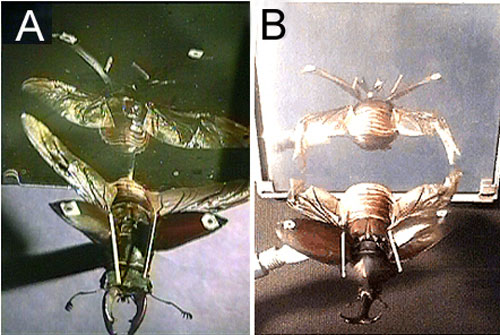
Broad opening of the elytra in lamellicornian
beetles. 3D filming of a beetle, tethered by the ventrite,
under a slant mirror. Still frames from video records. Artificial
landmarks (arrows) are glued to the elytra. (A) Lucanus cervus,
(B) Allomyrina dichotoma.
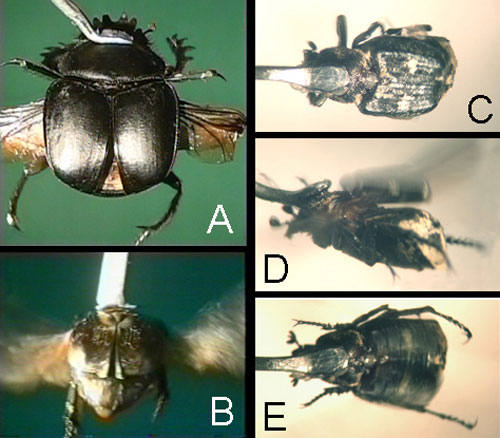
Restricted opening of the elytra in scarabaeid
beetles. 2D filming of a beetle, tethered by the pronotum.
Still frames. (A) Scarabaeus sacer, the moment of spreading,
view from above; (B) Protaetia lugubris, stationary flight,
view from behind; (C) Valgus hemipterus, before the start,
view from above, (D) stationary flight, in profile and (E) from
above.
The number of campaniform sensilla in their elytral
sensory field is diminished in comparison with beetles of closely
related taxa lacking that incision.
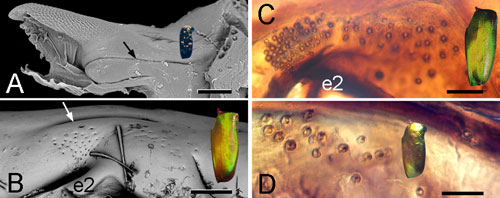
The root (A) and the Lehr’s fields of CFS (B-D)
in Cetoniini. Sensory fields are situated on medial faces
of a root. (A) Oxythyrea funesta, (B) Dicronorrhina
micans, (C) D. derbyana, (D) Protaetia aeruginosa.
The elytra in natural size are pasted into each photograph. (A,
B) SEM, (C, D) TLM. The arrows indicate the folds between the
lateral apophysis and the intermediate sector. Abbreviation: e2
– elytral process of 2Ax. Scale bars: (A-C) 100 µm, (D)
50 µm.
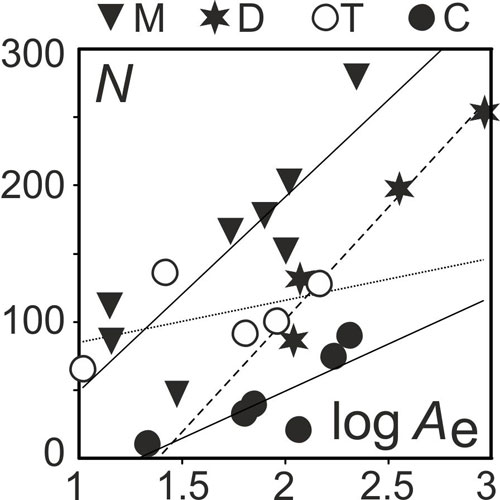
Allometric relationship between the area of the
elytron Ae (in mm2, logarithmic scale) and the number N of CFS
in Lehr’s field in the series of Cetoniini (series C) in comparison
with series of Dynastinae (D), Trichiini + Valgini (T) and Melolonthini
+ Rutelini (M). Markers for the series are shown above the plot.
Regression lines are solid for C, M, dashed for D, and dotted
for T. Values for the number of CFS in Cetoniini are lower in
comparison to other chafers of the same size.
Abundance of sensilla in brachyelytrous long-horn
beetles Necydalini does not suffer in comparison with macroelytrous
Cerambycinae.
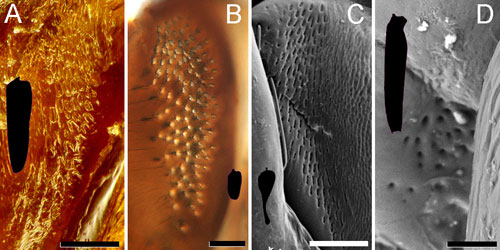
Lehr’s fields of CFS in long-horn beetles Cerambycidae
of approximately the same body size: (A) Rhagium sycophanta,
(B) Necydalis major, (C) Callisphyris macropus;
(D) Tragocerus spencei. The numbers of CFS in (A-D) are
respectively 52, 111, 138, and 19. Black outlines of the elytra
scaled 2:1 of the natural size are pasted into each photograph.
(A) epi-illuminated microscope, (B) TLM, (C, D) SEM. Scale bars
in (A-C) 50 µm, in (D) 20 µm.
Reduction of the sensory field was revealed in
brachyelytrous Staphylinidae. Stenoelytrous Oedemera and flying
Meloidae, unable to link their elytra down the suture, possess
the normal amount of sensilla, whereas the field in the stenoelytrous
Eulosia bombyliformis is by 5-6 times less than in chafers
of the same size but with normally linking broad elytra.
|
|



